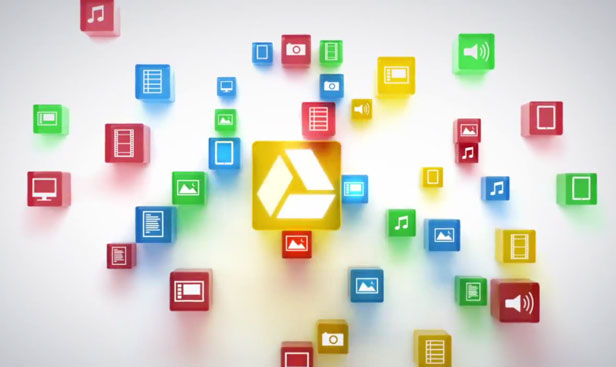Google’s Drive Adds to a Complicated Cloud

After roughly six years of rumors, Google has finally launched its own cloud storage and syncing service, called Google Drive. The service offers five gigabytes of online file storage for free and includes software that automatically synchronizes files between Windows and Apple computers, Android phones, and Google’s cloud. An iPhone app is due out in the “coming weeks,” Google says. Users can pay $2.49 a month for an extra 25 gigabytes of storage, or pay more for larger blocks up to a maximum of 16 terabytes. A post on Google’s official blog announced Google Drive.
Google’s latest product brings it into direct competition with Dropbox, a fast-growing startup seen as the leading provider of cloud storage and file syncing. Dropbox is reportedly valued at as much as $4 billion. The five gigabytes of storage that Google now offers is more than the two gigabytes that’s standard with a free Dropbox account, although Dropbox runs several promotions that make it relatively easy for a user to get five gigabytes or more for free. Dropbox offers 50 gigabytes of storage for $9.99 per month; a Google Drive user can get 100 gigabytes for half that price.
As mobile computers become more powerful, and it becomes possible for all forms of electronics to be Internet-connected, cloud-based data stores are increasingly important. Google Drive could also prove strategically important for Google. It will likely become tightly integrated into the company’s Android mobile operating system, enabling users to easily sync phones, tablets, and other computers.
Apple has a similar vision. The late Steve Jobs’s last product launch as Apple CEO was iCloud, which uses the Internet to synchronize data between Apple computers and mobile devices, but does not act as a data store and has been criticized for its lack of features. Perhaps preëmptively, Microsoft yesterday upgraded the capacity of its cloud storage service, SkyDrive, which integrates closely with its Windows Phone software and the upcoming Windows 8. Users of that service receive 25 gigabytes of storage for free, and can pay for more.
A number of innovative startups could be forced to rethink their plans as bigger players come to dominate the cloud storage market. Dropbox and others have been living in the shadow of rumors about Google Drive for roughly six years. Aaron Levie, founder of Box.com, decided in 2007 to pivot his company to serve businesses rather than consumers after hearing that Google’s cloud data store was imminent.
Levie believes Google executives changed their minds about the need to launch a cloud storage service in 2007, but the success of Dropbox and others forced them to revive the project. “Companies like Dropbox and SugarSync realized that there was a lot of consumer interest in this kind of product,” says Levie. “Google is in the business of serving large markets, so they had to get involved.”
Levie says cloud storage will become more important for many big technology companies. “If you were a company offering an operating system or large collection of online products, you want consumers’ data in your platform, because it makes you more sticky and able to connect everything together,” he says.
The way Google Drive is designed underlines that view. It is meant to be a place where you can work with data and documents, not just store them. More than 30 types of document can be viewed from the Google Drive site, including many video and image formats, and office documents can be edited there, too. Computer vision algorithms make it possible to search text in any images uploaded to Google Drive, and even to search for common objects such as the Eiffel Tower.
In an interview earlier this year, Dropbox founder Drew Houston told Technology Review that he was trying to build “the Internet’s file system.” “Whether it’s your TV or your camera or the apps on your phone, we want to make it easy for anything that consumes or creates data to be able to plug in,” he said.
Levie predicts intense competition between Google, Microsoft, Apple, and smaller companies such as Dropbox. But so far, Apple, Microsoft, and Google seem primarily focused on consumers rather than businesses. Levie thinks that leaves Box room to grow into a large business. Cloud storage for companies needs to be more customized and complex than a service that just stores and syncs photos and personal files, he claims, to allow integration with corporate working practices and greater control over security and access privileges. Google Drive will integrate with the company’s Apps service, which offers e-mail and online document editing for businesses, but this is not seen as a major business for Google compared to advertising revenue driven by its services for everyday Web users.
Keep Reading
Most Popular
Large language models can do jaw-dropping things. But nobody knows exactly why.
And that's a problem. Figuring it out is one of the biggest scientific puzzles of our time and a crucial step towards controlling more powerful future models.
How scientists traced a mysterious covid case back to six toilets
When wastewater surveillance turns into a hunt for a single infected individual, the ethics get tricky.
The problem with plug-in hybrids? Their drivers.
Plug-in hybrids are often sold as a transition to EVs, but new data from Europe shows we’re still underestimating the emissions they produce.
Stay connected
Get the latest updates from
MIT Technology Review
Discover special offers, top stories, upcoming events, and more.